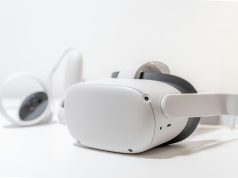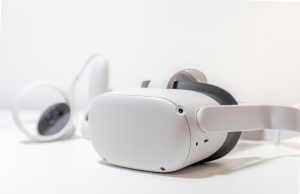
It’s no secret that the real estate industry is changing. The days of relying solely on agents and paper listings are coming to an end. With the rise of virtual reality technology, buyers can explore properties from the comfort of their own homes. VR allows potential buyers to “walk through” a property and get a realistic sense of what it would be like to live there. This is changing the way people buy homes and could potentially revolutionize the entire industry.
Let’s get started.
How is virtual reality being used in the real estate industry?
One of the primary ways virtual reality is being used in real estate is by creating walkthroughs for homes that are not yet built. This allows potential homeowners to get a preview of homes they might be interested in buying without travelling to the home and seeing it “in person”. A few companies, like Matterport, 3DVR and Vrtify, offer services that use 3D scanning technology to map out hard-to-reach areas of finished homes or models of yet-to-be constructed properties.
The scans allow home shoppers to take a virtual stroll down the hallways as well as peek into closets and other storage spaces within the building itself. The crypto market is also booming in virtual reality, so if you want to make some profit, I would suggest you trade on the Crypto Genius Website.
The benefits and drawbacks of virtual reality in real estate
Real estate marketers are taking advantage of Virtual Reality (VR) technology to change how they sell real estate. By using various devices such as Google Cardboard, Oculus Rift headsets, and Samsung Gear VR, brokers can show why a particular property is right for their clients. Brokers can also allow clients to experience the home before it has even been built with VR marketing technology.
While this allows them to showcase properties in previously unavailable ways, there are still drawbacks regarding virtual reality in real estate. Because the sensation of being “actually there” is an important part of making someone feel comfortable with buying a house sight unseen, some argue that virtual reality could cause more harm than good by giving buyers unrealistic expectations about what they’re getting upon purchase.
Driving factors of the expansion of virtual reality in real estate
- Virtual reality can create a wide array of digital environments and walk clients through them.
- Real estate agents can now show multiple houses, neighbourhoods, etc. worldwide without leaving their office.
- Many buyers and sellers already use virtual reality, so real estate companies need to catch up.
- Real estate agencies can now sell brand new developments without needing models.
Impacts of the expansion of virtual reality in real estate
- Creating a VR “walkthrough” is relatively inexpensive compared to building an actual model.
- Some people that would have been interested in development may not care to experience it first-hand practically.
- Clients’ ability to conveniently shop online from home reduces foot traffic through a physical office.
- The technology is relatively inexpensive and easy to implement
- Most people find virtual reality exciting and interesting
The Bottom Line
Virtual Reality is changing how potential homebuyers view properties, and companies are starting to pick up on that trend. Virtual reality allows home buyers to tour a property before seeing it in real life, drastically improving their experience while simultaneously streamlining the process for brokers. As the use of VR continues to gain popularity, agents who invest in VR technologies will be able to capture more business than those who do not.













